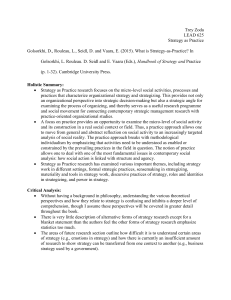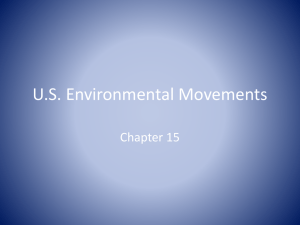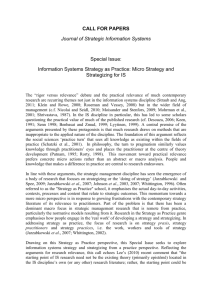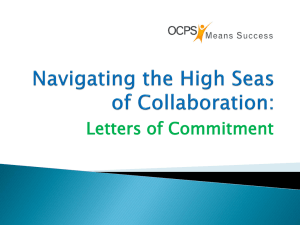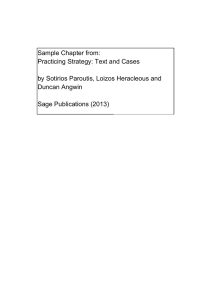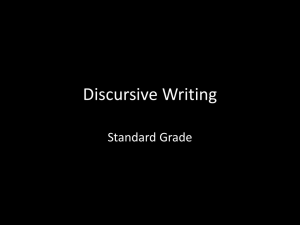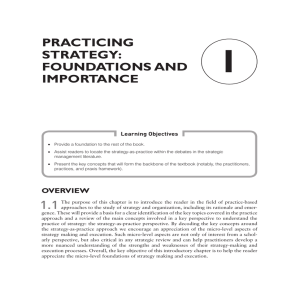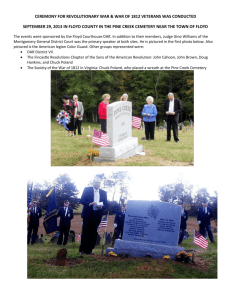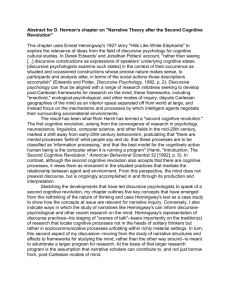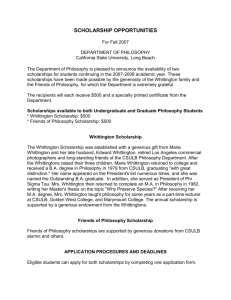Euram2016_Strategy Processes and Practices
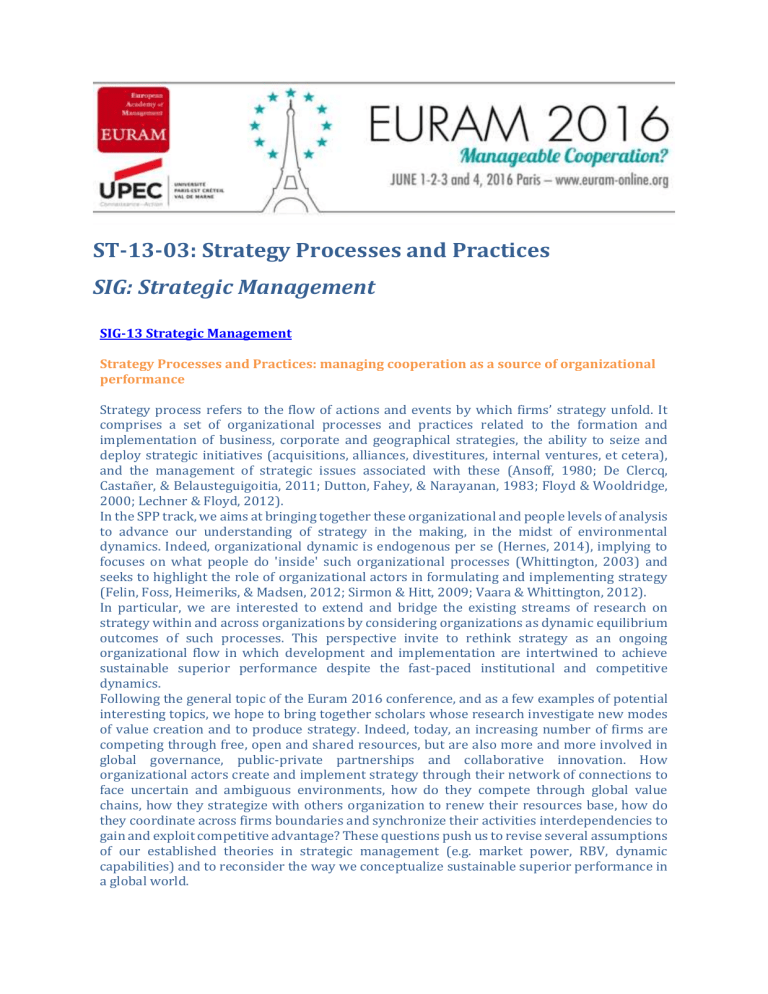
ST-13-03: Strategy Processes and Practices
SIG: Strategic Management
SIG-13 Strategic Management
Strategy Processes and Practices: managing cooperation as a source of organizational performance
Strategy process refers to the flow of actions and events by which firms’ strategy unfold. It comprises a set of organizational processes and practices related to the formation and implementation of business, corporate and geographical strategies, the ability to seize and deploy strategic initiatives (acquisitions, alliances, divestitures, internal ventures, et cetera), and the management of strategic issues associated with these (Ansoff, 1980; De Clercq,
Castañer, & Belausteguigoitia, 2011; Dutton, Fahey, & Narayanan, 1983; Floyd & Wooldridge,
2000; Lechner & Floyd, 2012).
In the SPP track, we aims at bringing together these organizational and people levels of analysis to advance our understanding of strategy in the making, in the midst of environmental dynamics. Indeed, organizational dynamic is endogenous per se (Hernes, 2014), implying to focuses on what people do 'inside' such organizational processes (Whittington, 2003) and seeks to highlight the role of organizational actors in formulating and implementing strategy
(Felin, Foss, Heimeriks, & Madsen, 2012; Sirmon & Hitt, 2009; Vaara & Whittington, 2012).
In particular, we are interested to extend and bridge the existing streams of research on strategy within and across organizations by considering organizations as dynamic equilibrium outcomes of such processes. This perspective invite to rethink strategy as an ongoing organizational flow in which development and implementation are intertwined to achieve sustainable superior performance despite the fast-paced institutional and competitive dynamics.
Following the general topic of the Euram 2016 conference, and as a few examples of potential interesting topics, we hope to bring together scholars whose research investigate new modes of value creation and to produce strategy. Indeed, today, an increasing number of firms are competing through free, open and shared resources, but are also more and more involved in global governance, public-private partnerships and collaborative innovation. How organizational actors create and implement strategy through their network of connections to face uncertain and ambiguous environments, how do they compete through global value chains, how they strategize with others organization to renew their resources base, how do they coordinate across firms boundaries and synchronize their activities interdependencies to gain and exploit competitive advantage? These questions push us to revise several assumptions of our established theories in strategic management (e.g. market power, RBV, dynamic capabilities) and to reconsider the way we conceptualize sustainable superior performance in a global world.
The SPP track also aims at drawing on theoretical and methodological streams novel to the study of strategy such as sociology, social psychology, linguistics, and political science. For instance, discursive (Knights & Morgan, 1991; Paroutis & Heracleous, 2013) and narrative
(Barry & Elmes, 1997; Fenton & Langley, 2011) analyses have helped us to better understand the role of language and communication in strategic decision-making and how firms cope with environmental dynamics. Furthermore, consistent with Tsoukas and Chia (2002) call to delve into organizational processes, methods such as participant observation (Laine & Vaara, 2007), ethnography (Samra ‐ Fredericks, 2003; Watson, 2013), video ethnography (Liu & Maitlis,
2014) and discourse analysis (Kwon, Clarke, & Wodak, 2014; Mantere & Vaara, 2008), formerly rarely used in conventional strategy research, have been fruitfully applied to open fertile research avenues by scholars interested in the human foundations of strategic management.
We believe that such disciplines can enhance our theorizations about strategic processes.
Sébastien Picard, Toulouse School of Management
Aura Parmentier Cajaiba, Institut Supérieur d’Economie et de Management
Keywords
Strategy Process, Strategy-As-Practices, Strategy implementation, Strategy Work, Cognition and Attention, Resource Microfoundations, Process studies
Reference
Ansoff, H. I. (1980). Strategic issue management. Strategic Management Journal, 1(2),
131-148.
Barry, D., & Elmes, M. (1997). Strategy retold: Toward a narrative view of strategic discourse. Academy of management review, 22(2), 429-452.
De Clercq, D., Castañer, X., & Belausteguigoitia, I. (2011). Entrepreneurial initiative selling within organizations: towards a more comprehensive motivational framework. Journal of Management Studies, 48(6), 1269-1290.
Dutton, J. E., Fahey, L., & Narayanan, V. K. (1983). Toward understanding strategic issue diagnosis. Strategic Management Journal, 4(4), 307-323.
Felin, T., Foss, N. J., Heimeriks, K. H., & Madsen, T. L. (2012). Microfoundations of routines and capabilities: Individuals, processes, and structure. Journal of
Management Studies, 49(8), 1351-1374.
Fenton, C., & Langley, A. (2011). Strategy as practice and the narrative turn.
Organization Studies, 32(9), 1171-1196.
Floyd, S. W., & Wooldridge, B. (2000). Building strategy from the middle:
Reconceptualizing strategy process. London: Sage.
Knights, D., & Morgan, G. (1991). Corporate strategy, organizations, and subjectivity: A critique. Organization Studies, 12(2), 251-273.
Kwon, W., Clarke, I., & Wodak, R. (2014). Micro ‐ Level Discursive Strategies for
Constructing Shared Views around Strategic Issues in Team Meetings. Journal of
Management Studies, 51(2), 265-290.
Laine, P.-M., & Vaara, E. (2007). Struggling over subjectivity: A discursive analysis of strategic development in an engineering group. Human Relations, 60(1), 29-58.
Lechner, C., & Floyd, S. W. (2012). Group influence activities and the performance of strategic initiatives. Strategic Management Journal, 33(5), 478-495.
Liu, F., & Maitlis, S. (2014). Emotional dynamics and strategizing processes: a study of strategic conversations in top team meetings. Journal of Management Studies,
51(2), 202-234.
Mantere, S., & Vaara, E. (2008). On the problem of participation in strategy: A critical discursive perspective. Organization Science, 19(2), 341-358.
Paroutis, S., & Heracleous, L. (2013). Discourse revisited: Dimensions and employment of first ‐ order strategy discourse during institutional adoption. Strategic
Management Journal, 34(8), 935-956.
Samra ‐ Fredericks, D. (2003). Strategizing as Lived Experience and Strategists’
Everyday Efforts to Shape Strategic Direction*. Journal of Management Studies,
40(1), 141-174.
Sirmon, D. G., & Hitt, M. A. (2009). Contingencies within dynamic managerial capabilities: interdependent effects of resource investment and deployment on firm performance. Strategic Management Journal, 30(13), 1375-1394.
Tsoukas, H., & Chia, R. (2002). On organizational becoming: Rethinking organizational change. Organization Science, 13(5), 567-582.
Vaara, E., & Whittington, R. (2012). Strategy-as-practice: taking social practices seriously. The Academy of Management Annals, 6(1), 285-336.
Watson, T. J. (2013). Entrepreneurship in action: bringing together the individual, organizational and institutional dimensions of entrepreneurial action.
Entrepreneurship & Regional Development, 25(5-6), 404-422.
Whittington, R. (2003). The work of strategizing and organizing: for a practice perspective. Strategic organization, 1, 117-126.
